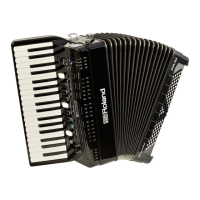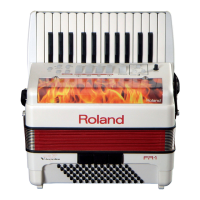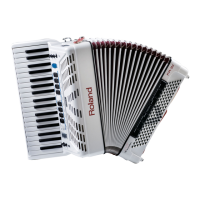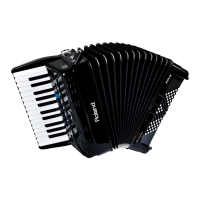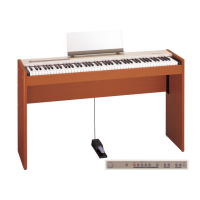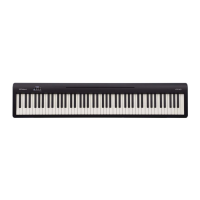Editing sounds | SYSTEM parameters
60
r
FR-7/FR-5 V-Accordion
even more detailed. It would be a good idea to select
each curve without the “Fixed” addition, play a few
notes, select the next curve, etc. until you find the
response that feels just right.
8.4 Pedal Controller
This page allows you to assign
functions to the FBC-7’s foots-
witches. As you will notice
below, there are also functions
for remotely controlling exter-
nal instruments, like a DisCover 5M, an arranger mod-
ule or any other sequencer that understands the mes-
sages transmitted by the FBC-7.
Note: The assignments you program here are only meaningful if
you connect the FR-7/FR-5 to the supplied FBC-7.
(1) If necessary, press the [DATA÷ENTER] knob to select
the “SWITCH” parameter, then rotate the
[DATA÷ENTER] knob to select the footswitch on the
FBC-7 whose function you wish you define.
(2) Press the [DATA÷ENTER] knob to select the
“ASSIGN” parameter, then rotate the [DATA÷ENTER]
knob to select one of the following functions:
■ Set Up/Set Down—The footswitch allows you to select
the next (Down) or previous (Up) Set memory. After select-
ing Set 01 (or 40), pressing the footswitch again takes you
to Set 40 (or 01). These are the default functions of foots-
witches [1] and [2].
Note: There is also a function that allows you to assign a spe-
cific Set number to a footswitch (see “Set 1~30” below).
■ Regist Up/Regist Dwn—The selected footswitch allows
you to select the next (Down) or previous (Up) Treble regis-
ter. If you combine this with the “2.12 Bass Link” and “2.13
Orchestra Link” parameters, this allows you to reconfigure
almost all sections simply by pressing this footswitch.
Note: There is also a function that allows you to assign a spe-
cific register number to a footswitch (see “Register 1~14”
below).
■ Treble Sust*—The footswitch can be used to hold the
Treble notes (accordion) whose keys you are holding down
when you press the footswitch. You can then release the
keys – the notes go on sounding until you release the foot-
switch.
■ Bass Sust*—The footswitch can be used to hold the bass
notes of the Bass section (but not the chords).
■ Chord Sust*—The footswitch can be used to hold the
chord notes of the Bass section (but not the bass notes).
■ Orch Sust—The footswitch can be used to hold the
Orchestra notes of the Treble section.
■ Orch Bs Sust*—The footswitch can be used to hold the
Orchestra notes of the Bass section.
Note: The entries marked with an asterisk “*” only apply to the
MIDI messages transmitted by the section in question to an
external instrument. They do not affect the FR-7/FR-5’s sound
source.
■ Orch On/Off—The footswitch can be used to switch the
Orchestra Treble section on and off. This has no effect on
the Orchestra’s mode setting, nor can you specify which
Orchestral sound should be used. (You can, however, use
“2.13 Orchestra Link” for that.)
■ Start/Stop—This setting only makes sense if you connect
the FBC-7’s MIDI OUT socket to the MIDI IN socket of an
external sequencer, arranger module, drum machine or
DisCover 5M. Pressing the footswitch once will cause the
external device to start playback. Obviously, you need to
load the desired song, select a Music Style, etc., beforehand.
Press the footswitch again to stop playback.
■ Intro—This setting only makes sense if you connect the
FBC-7’s MIDI OUT socket to the MIDI IN socket of an
arranger module. In this case, the footswitch can be used
to select the “Intro” pattern of the active Music Style.
Note: Arranger instruments of other manufacturers may not
understand this message. If in doubt, see their MIDI implemen-
tation section for details. The MIDI message transmitted by
this footswitch is PC83 (program change) on MIDI channel 10.
■ Fill Down—This setting only makes sense if you connect
the FBC-7’s MIDI OUT socket to the MIDI IN socket of an
arranger module. In this case, the footswitch can be used
to select a fill-in pattern of the active Music Style that
selects a more scarcely orchestrated accompaniment pat-
tern upon completion.
Certain arranger instruments provide four accompaniment
levels, so that you could use this footswitch up to three
times to return to the most fundamental level (please see
the manual of the arranger instrument you’re controlling
to find out how many levels it provides). If you then press
the footswitch again, however, nothing happens. You thus
cannot cycle back to the highest level (which is called
“Variation” on older Roland arranger instruments).
Note: Some arranger instruments provide only two accompa-
niment levels.
Note: Arranger instruments of other manufacturers may not
understand this message. The MIDI message transmitted by
this footswitch is PC82 (program change) on MIDI channel 10.
■ Fill Up—This setting only makes sense if you connect the
FBC-7’s MIDI OUT socket to the MIDI IN socket of an
arranger module. In this case, the footswitch can be used
to select a fill-in pattern of the active Music Style that
selects a more richly orchestrated accompaniment pattern
upon completion.
Depending on the arranger instrument you’re controlling,
you could use this footswitch up to three times to jump to
the most complex level. If you then press the footswitch
again, however, nothing happens. You thus cannot cycle
back to the lowest level (which is called “Original” on older
Roland arranger instruments).
Note: Some arranger instruments provide only two accompa-
niment levels.
Note: Arranger instruments of other manufacturers may not
understand this message. The MIDI message transmitted by
this footswitch is PC81 (program change) on MIDI channel 10.
■ Ending—This setting only makes sense if you connect
the FBC-7’s MIDI OUT socket to the MIDI IN socket of an
arranger module. The footswitch can be used to select the
“Ending” pattern of the active Music Style.
Note: Arranger instruments of other manufacturers may not
understand this message. If in doubt, see their MIDI implemen-
tation section for details. The MIDI message transmitted by
this footswitch is PC84 (program change) on MIDI channel 10.
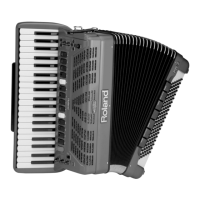
